#greenland seal
Photo
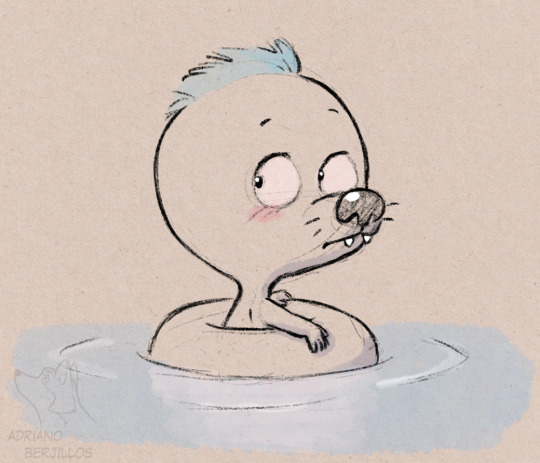
Goran, stop being so cute! >_<
...
...and don't pee in the pool.
Goran © Hélène Bruller, Zep and Futurikon
14 notes
·
View notes
Text
#good news#science#environmentalism#nature#environment#animals#seal#marine life#ringed seal#greenland#west greenland#arctic#ocean#ocean life#conservation
83 notes
·
View notes
Text
#greenland#norse history#super interesting#although at the end when it says europeans could have never adapted to inuit life to survive i'm :////#i keep seeing it mentioned elsewhere that centuries after the norse settlement was abandoned they found the body of a norse person#in a inuit-style seal skin in greenland#so i'm sure not all of them#but a few maybe#and there is evidence of some european settlers in n. america going to live in indigenous communities from time to time especially early on#i feel like that creates this implication that living like that is too uncivilized compared to european way of life that it wouldn't have#even been thinkable...#:(
2 notes
·
View notes
Text
Polar bears in the Arctic Circle rely on sea ice to help them hunt for seals, their main source of food. But with warming temperatures brought on by human-caused climate change, that sea ice is melting sooner in the spring and freezing later in the fall, forcing the bears to go hungry for longer periods of time than they normally do.
Now, researchers have discovered a unique group of polar bears who’ve found an innovative way to survive in the absence of sea ice: By hunting from the ice that breaks off glaciers. The bears live in southeast Greenland and are a genetically distinct subpopulation, which suggests they’ve been isolated from other polar bears for around 200 years, according to a paper published this week in Science.
The findings offer a glimmer of hope for a species that, without intervention to halt climate change, will be trending towards extinction by the end of the decade. The researchers urged caution against extrapolating their findings to other populations of polar bears, who live in areas without glacial ice and are still increasingly threatened by the planet’s warming. The Arctic Ocean, research has found, is warming four times faster than the rest of the world.
“[The findings] show us how some polar bears might persist under climate change, but I don’t think glacier habitat is going to support huge numbers of polar bears,” Kristin Laidre, a polar research scientist at the University of Washington, tells CNN’s Ashley Strickland. “There’s just not enough of it. We still expect to see large declines in polar bears across the Arctic under climate change.”
— A Clever Population of Polar Bears Survives on Glacial Ice in Greenland
#sarah kuta#a clever population of polar bears survives on glacial ice in greenland#current events#environmentalism#global warming#climate change#ecology#wildlife conservation#animals#animal behaviour#meteorology#arctic circle#greenland#bears#polar bears#seals#ice#sea ice#glaciers
4 notes
·
View notes
Text
Huge news for fans of ringed seals or, as they are known here in Finland, norps, a new norp just dropped!
6K notes
·
View notes
Link
Polar bears in the Arctic Circle rely on sea ice to help them hunt for seals, their main source of food. But with warming temperatures brought on by human-caused climate change, that sea ice is melting sooner in the spring and freezing later in the fall, forcing the bears to go hungry for longer periods of time than they normally do.
Now, researchers have discovered a unique group of polar bears who’ve found an innovative way to survive in the absence of sea ice: By hunting from the ice that breaks off glaciers. The bears live in southeast Greenland and are a genetically distinct subpopulation, which suggests they’ve been isolated from other polar bears for around 200 years, according to a paper published this week in Science.
The findings offer a glimmer of hope for a species that, without intervention to halt climate change, will be trending towards extinction by the end of the decade. The researchers urged caution against extrapolating their findings to other populations of polar bears, who live in areas without glacial ice and are still increasingly threatened by the planet’s warming. The Arctic Ocean, research has found, is warming four times faster than the rest of the world.
#current events#environmentalism#global warming#climate change#ecology#wildlife conservation#animals#animal behaviour#meteorology#arctic circle#greenland#bears#polar bears#seals#ice#sea ice#glaciers
1 note
·
View note
Text
If you've ever seen a list of 'History fun facts' you might have run into the fact that "Oxford University was founded before the Aztec Empire." This is true, but it's interesting that this is considered a fun fact. There is this general thought or idea that indigenous empires and societies were 'ancient'. Here on Tumblr I've seen the ruins of Machu Picchu tagged as ancient history (it was founded in the 1400s). In games like Civilization aztec jaguar warriors and incan sling-units are ancient units.
I think this idea is caused by a general view on many non-European societies as unchanging and static before European contact. I know this isn't a very novel take, but I think it's interesting because this belief has had a great impact on how colonisers governed their colonial subjects - and I think it still has an important impact today.
You're probably wondering how I'll make this about Greenland and you'll have to wonder no more. For a long time in the 1700s and 1800s the policies of the danish colonisers in Greenland often held that they were in place to preserve the traditional Greenlandic way of life. This was pretty absurd coming from the same people trying to eradicate the current religious and spiritual practices of the Greenlanders/Kalaallit. While its debateable how influential this goal actually was on policies, I do think that it created a very rigid view of what the Kalaallit should be. In the early 19th century southern Greenland was hit by famine as the amount of seals plummeted. Despite this the danish administration still pushed for seal hunting, only selling equipment for seal hunting and increasing the rewards for capturing seals. The famine could probably have been avoided had they started to provide better fishing equipment, but this was frowned upon. Green landers were supposed to catch seals, the Danish colonial administration thought.
Even today some people view indigenous people as wrong for not acting 'traditional' enough. I've seen people say Greenlandic seal hunting isn't actually traditional because they used motorized snow scooters and rifles instead of dog sleds and spears. Similarly with the Faroese whale slaughter because they use motor boats instead of row boats.
This post was written entirely because I've always really hated that fun fact because I hate fun and I hate facts.
2K notes
·
View notes
Text
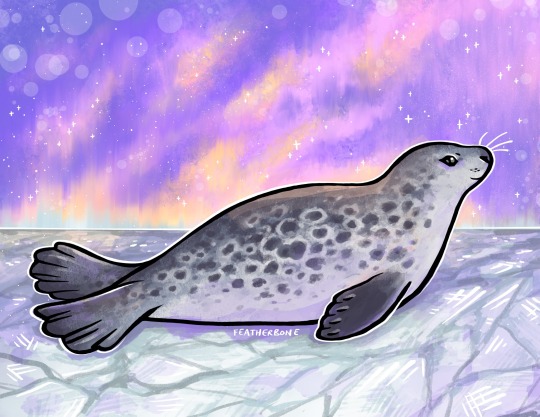
Ringed seal! Smallest and most common arctic seal. Apparently there’s a fancy “new” distinct ecotype in Greenland that was described this year! :-)
[ID: an illustration of a grey seal with white ring markings on its back in profile facing to the right. It is laying on ice with its head up, against a purple and orange galaxy background. End.]
415 notes
·
View notes
Text

Seal fur thong. 19th century. Inuit in East Greenland
2K notes
·
View notes
Photo

More sketches of Goran, the cute seal from "The Minimighty Kids". And yes, he wets the bed (in fact, as superhero, he is "Super bed wetter" ), maybe he should be used to wear diapers in the nights!
Isn't he a cutie?
Goran © Hélène Bruller, Zep and Futurikon
10 notes
·
View notes
Note
There’s a Carcharodon known as “the Greenland Beast” who’s armor is so smooth he just slides around the battlefield at incredible speeds. It looks like he’s using Heelies but he’s just that smooth. Just slidin
The Greenland Beast leads the chapter's premier fast attack company. He doesn't need a bike;skates along on his boots (ironically) like a baby seal, careening through infantry like bowling pins
137 notes
·
View notes
Text
Animal of the Day!
Greenland Shark (Somniosus microcephalus)
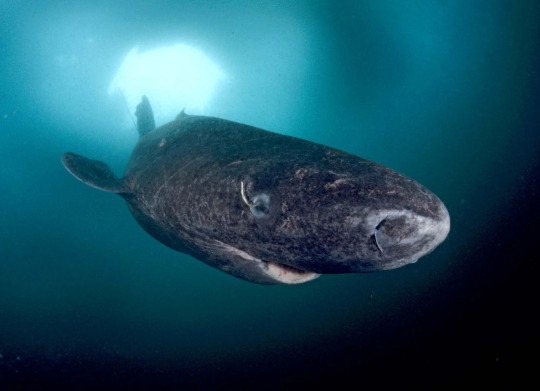
(Photo from Britannica)
Conservation Status- Vulnerable
Habitat- Northern Atlantic; Arctic Ocean
Size (Weight/Length)- 4 m
Diet- Fish; Seals; Small whales
Cool Facts- The world’s oldest Greenland shark may have witnessed the first European boats making their way across the Atlantic to reach the Americas. It is estimated that Greenland sharks can live anywhere from 250 years old all the way to 500. They are extremely slow growing, most likely due to the freezing waters they live in. These sharks are not sexually mature until they turn 150 and a pregnancy can last up to 18 years. They are slow moving, apex predators, targeting sick or sleeping animals which can include moose or caribou swimming between islands. Unfortunately, Greenland sharks are killed for their flesh that is considered a delicacy in Iceland. Overhunting, bycatch, and an extremely slow generation time are the leading reasons for the decline of Greenland shark populations.
Rating- 12/10 (Most of what we know about them is conjecture.)
#animal of the day#animals#sharks#marine life#marine biology#friday#january 5#greenland shark#biology#science#conservation#the more you know
216 notes
·
View notes
Text
When temporary ice sheets form on the ocean during each fall’s freeze, the bears walk across it in search of food, often by sitting next to gaps in the ice and waiting for seals to come up for air. When the ice melts in the spring thaw, polar bears typically survive between 100 and 180 days without food until the ice forms again, reports Live Science’s Harry Baker. As temperatures rise, however, that fasting period is becoming longer, which is harming the bears and pushing them toward starvation.
The bears living in southeast Greenland go even longer without sea ice—around 250 days. But they’ve been able to continue hunting during that period by using glacial mélange, or chunks of ice that break off from glaciers into the water.
Researchers had long known about the southeast Greenland bears because of indigenous knowledge and historical records. But until now they hadn’t studied these bears’ genetics and behavior. Scientists studied 36 years of GPS collar tracking data, tissue samples, helicopter observations and other data to get a fuller picture of the polar bears. Though exact numbers were hard to estimate, they suspect there are around 300 individuals in this group, per Live Science.
[…]
And though the southeast Greenland bears have adapted to survive in their surroundings, rising temperatures may ultimately cause their glacial ice to shrink, too. As Steve Armstrup, a scientist with Polar Bears International who was not involved in the study, tells the New York Times’ Henry Fountain, the study “is not some kind of salvation for polar bears.” While the southeast Greenland bears are able to hunt via glacial ice today, he says, “going into the future, that will change unless we arrest the rise of global greenhouse gases.”
— A Clever Population of Polar Bears Survives on Glacial Ice in Greenland
#sarah kuta#a clever population of polar bears survives on glacial ice in greenland#current events#environmentalism#global warming#climate change#ecology#wildlife conservation#animals#animal behaviour#meteorology#arctic circle#greenland#bears#polar bears#seals#ice#sea ice#glaciers
0 notes
Text



Victorian Sunderland Lustre Frog mug printed with ships portrait of a Hull Whaling Ship & inscribed 'Truelove from Hull' 'There's sunshine on the sea my love. There's beauty oe'r the skies. But fairer seem thy looks my love and brighter are thine eyes', within orange borders, H12cm. 19th century
The 'Truelove' was built in Philadelphia in 1764 and came into English hands during the American War of Independence where she had been used as a privateer. She was sold to John Voase, a wine merchant and ship owner in Hull, and was converted into a whaling ship. The 'Truelove' made over 80 voyages, killing over 500 whales as well as seals, walruses, narwhals and polar bears. The 'Truelove' also brought wine from Oporto and for 9 years she engaged in general trade with the Baltic ports. In 1835 the 'Truelove' was one of a fleet trapped in ice in Melville Bay, Greenland.
Twenty of the fleet were crushed but 'Truelove' survived unharmed. Captain Wells described her as 'handy as a cutter, safe as a lifeboat, and tight as a bottle'. The 'Truelove' was the last of the Hull whalers and sailed alongside the steam powered whaling vessels in the 1850's and 60's. In 1873 she travelled to her home port of Philadelphia and was presented with a flag in honour of her 'birth' there 109 years earlier.
After her visit to Philadelphia there were calls to have her made into a floating museum but this never came about and she ended her days as a bulk on the Thames before she was finally broken up in the late 1890's. The 'Truelove' was in use for over 130 years, outliving all other vessels of her class who were built at the same time
218 notes
·
View notes
Text
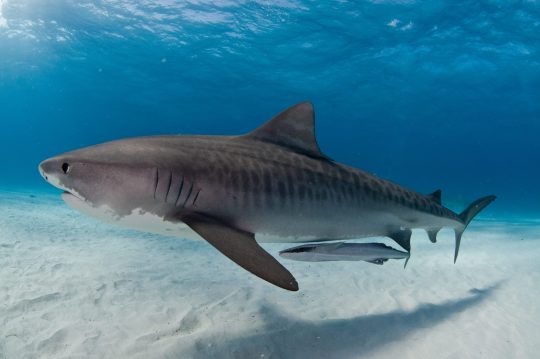
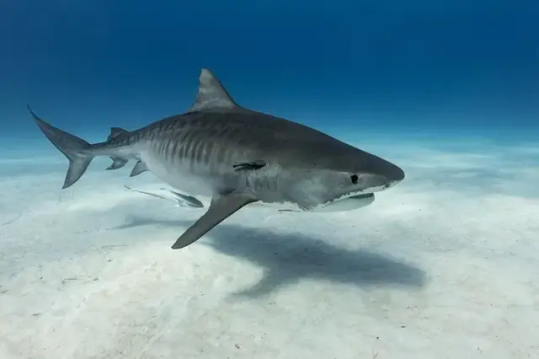

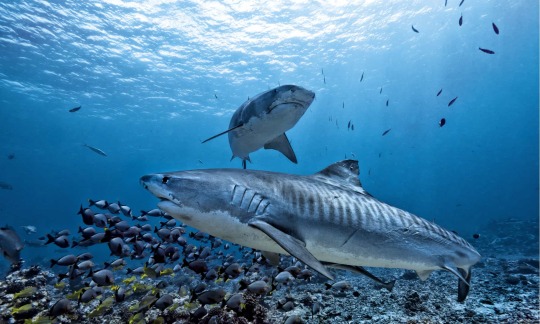
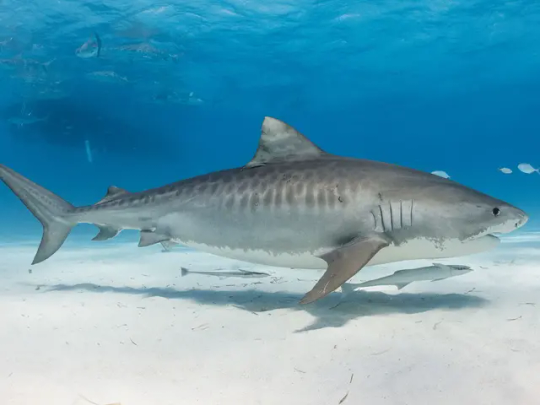
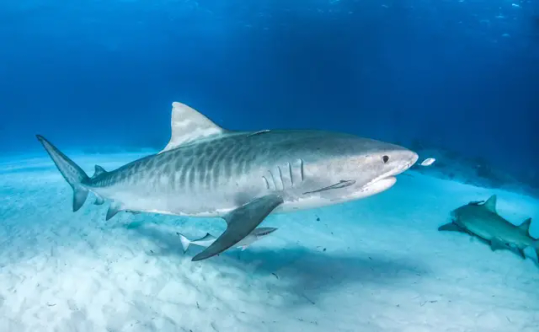
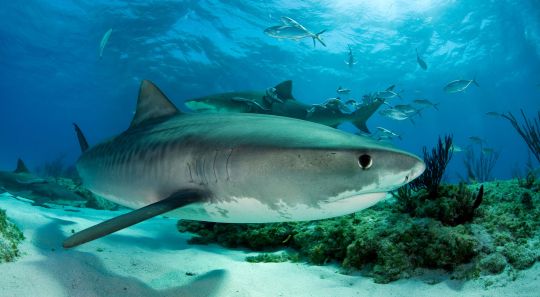
The tiger shark is a species of ground shark, and the only extant member of the genus Galeocerdo and family Galeocerdonidae. It is a highly nomadic species which inhabits tropical and subtropical waters world wide up to 3,000ft (900m) in depth, and is often found in coastal waters with particular abundance in the gulf of mexico, Caribbean sea, Indian ocean, and western pacific. Tiger sharks are often call the garbage cans of the sea and have reputation for eating almost anything. As such there diet is wide and heavily varied an is known to regularly include: small fish, jellyfish, crustaceans, cephalopods and other mollusks, rays, skates, sawfish, sea birds, sea snakes, sea turtles, other sharks, dolphins, seals, sea lions, dugongs, manatees, crocodilians, porpoises, and sick or injured whales. When near islands or coastlines they have been known to eat sheep, goats, dogs, pigs, rats, horses, deer, cattle, cats, camels, monkeys, inland birds, bats, lizards and inedible objects, such as license plates, cans, tires, books, boat oars, soccerballs and baseball bats. Tiger sharks are themselves occasionally preyed upon by orcas, great whites, and saltwater crocodiles. The tiger shark commonly reaches 10.5-14ft (3.2 -4.26m) in length and 385- 1400lbs (175 – 635kg) in weight, with the largest recorded reaching 18ft (5.5m) long and 3360lbs (1525kg). This ranks the tiger shark amongst the largest extant sharks on earth only being surpassed by the whale, basking, great white, pacific sleeper, Greenland, and blunt nosed sixgill sharks. They have a broad snout and stocky body with proportionally large fins and a long upper tail. Tiger shark teeth are unique with very sharp, pronounced serrations and an unmistakable sideways-pointing tip. Such dentition has developed to slice through flesh, bone, and other tough substances such as turtle shells. In the northern hemisphere the mating season takes place from march to may and the southern hemisphere from November to January, with males breeding every year while females breed once every 3 years. After a year long pregnancy mother tiger sharks give birth to 10 to 80 pups. Under ideal conditions a tiger shark may live upwards of 12 years.
#pleistocene#pleistocene pride#pliestocene pride#pliestocene#fish#shark#shark week#tiger#tiger shark
210 notes
·
View notes
Text
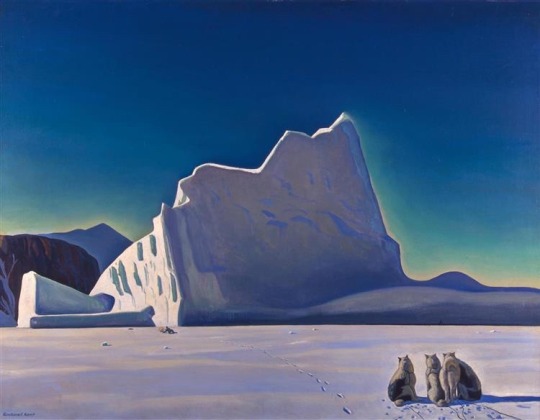
Rockwell Kent
Seal Hunter, North Greenland
1933
#rockwell kent#american art#american artist#american painter#american painting#landscape#landscape art#landscape painting#greenland#nature#modern art#art history#aesthetictumblr#tumblraesthetic#tumblrpic#tumblrpictures#tumblr art#aesthetic#beauty
76 notes
·
View notes